Microsoft Surface Book 3 (15) review – Stranger Things or the new normal
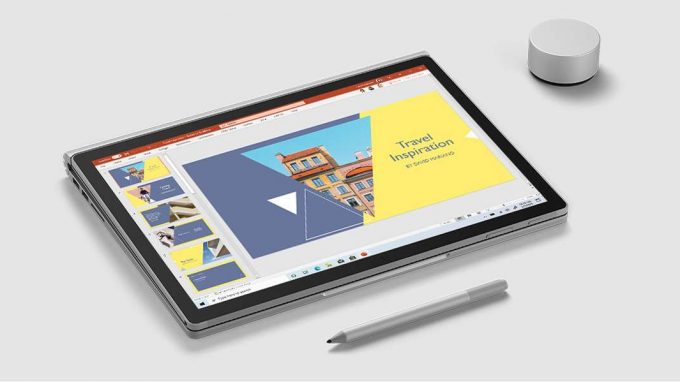 One of the most intriguing devices on the market is truly the Microsoft Surface Book 3. No matter if you’re going for the 13.5-inch or the 15-inch model, the ability to pop the display and do some quick work on the go is outstanding. Furthermore, it is groundbreaking that the CPU is located in the “tablet”, while the GPU resides inside the base.
One of the most intriguing devices on the market is truly the Microsoft Surface Book 3. No matter if you’re going for the 13.5-inch or the 15-inch model, the ability to pop the display and do some quick work on the go is outstanding. Furthermore, it is groundbreaking that the CPU is located in the “tablet”, while the GPU resides inside the base.
With that said, the Surface Book 3 (15) is a small powerhouse that holds a Core i7-1065G7 (yes, a ULV processor), and a GTX 1660 Ti Max-Q. We’re very interested to see if this processor is going to bottleneck such a potentially powerful graphics card, and how exactly did Microsoft manage to execute the communication between the two.
The great thing about this configuration is that the keyboard dock portion of the device actually has its own battery that significantly improves the battery life of the tablet – more on that, later.
You can check the prices and configurations in our Specs System: https://laptopmedia.com/series/microsoft-surface-book-3-15-0/
Contents
Specs Sheet
- Mostrar
- 15.0”, 3K (3240 x 2160), IPS
- HDD/SSD
- hasta 2000GB SSD
- RAM
- up to 32GB
- OS
- Windows 10 Home, Windows 10 Pro
- Material del cuerpo
- Magnesium alloy
- Dimensiones
- 343 x 251 x 15 ~ 23 mm (13.50" x 9.88" x 0.59")
- Peso
- 1.90 kg (4.2 lbs)
- Puertos y conectividad
- 2x USB Type-A
- 3.2 Gen 2 (10 Gbps)
- 1x USB Type-C
- 3.2 Gen 2 (10 Gbps), Power Delivery (PD)
- Lector de tarjetas
- SDXC
- Wi-Fi
- 802.11ax
- Bluetooth
- 5.0
- Conector de audio
- 3.5 Combo Jack
- Features
- Lector de huellas dactilares
- Cámara web
- 5.0MP Front-Facing + 8.0MP Rear-Facing
- Teclado retroiluminado
- optional
- Micrófono
- Dual far-field Studio Mics
- Altavoces
- Front-facing stereo speakers with Dolby Atmos
- Unidad óptica
- Ranura de bloqueo de seguridad
Todo Microsoft Surface Book 3 (15.0″) configuraciones
What’s in the box?
As usual, this Microsoft device comes in an unorthodox package. Beware, because the outside package holds the 127W power brick since it wouldn’t fit inside the branded box inside. By the way, the power adapter has a USB Type-A port for charging with 7W of power. Other than that, there are your mandatory paper manuals, and the laptop, itself.
Design and construction
Make no mistakes, this is not your average thin and light notebook. The laptop goes all the way from 15mm to 23mm in thickness, because of its unorthodox hinge mechanism. And the total weight of the package stops the scales at 1.9 kg. Of course, the build materials are nothing short of premium with the entire casing being made out of magnesium. And this results in an incredibly solid product – both looking at the base, and the display.
Speaking of the display, you will be able to open the lid with a single hand. This is pretty much where the hinge mechanism comes into place – its serpentine shape provides good balance and smooth operation. However, we feel it was a bit bouncy when the display is opened. Here, you can see that the screen is protected by a glass sheet, and inside the top bezel, you’ll find the Windows Hello-certified camera that has a 5MP sensor with 1080p video recording capability. Also, there is a camera on the back, which has an 8MP sensor and can also shoot in 1080p. So, at the end of the day, this is the ultimate conference call beast. In addition to that, the speakers hide in the grills around the display.
Next, let’s move to the base. While it can be clearly seen on the images we took, there is a profound curvature on the keyboard dock. It is not something that is hindering the usability of the device, but we just thought it’s good to let you know, as this is one of the few laptops that feature such a thing. Other than that, the keyboard is okay, although we found the feedback to be a bit soft, and the key travel to be on the short side, but at least there is a backlight. The interesting thing here is the dedicated detachment button. Once you press it, you need to wait a couple of seconds before the entire sequence of disconnection is executed. After that, you will hear a popping sound and you can safely remove the display out of its resting place. Pull bravely, as the magnets are still holding it in place, with the help of gravity.
To reattach it to the chassis, you only need to put it in the slots, and by the way – you can switch the display either way – it will work. One last thing we didn’t mention is the touchpad. While it has a glass surface that provides great gliding and tracking, we feel that it is just too small. However, this can be forgiven, since the laptop works great with a stylus, although you need to buy it separately (or to find an appropriate bundle offer).
Lastly, the hot air from the graphics card is exhausted from the vents on the top backside of the base – towards the display.
Ports
Pretty much all of the I/O here is found on the keyboard dock. On the left, you can see two USB Type-A 3.2 (Gen. 2) ports, as well as an SD card reader, while the right is home to the proprietory charging plug and the USB Type-C 3.2 (Gen. 2) port. Furthermore, there is a charging plug on the display/tablet itself, and on top, you will find the Power button and the volume rocker. Also, the laptop has an Audio jack on the right side of the display.
Display quality
Microsoft Surface Book 3 (15) has an IPS touchscreen panel with a model number LP150QD112604. Its diagonal is 15″ (38.1 cm), and the resolution – 3240 x 2160. Additionally, the screen ratio is 3:2, the pixel density – 260 ppi, their pitch – 0.1 x 0.1 mm. The screen can be considered Retina when viewed from at least 33 cm (from this distance, the average human eye can’t see the individual pixels).

Its viewing angles are great. We have provided images at 45 degrees to evaluate quality.

The maximum measured brightness is 390 nits (cd/m2) in the middle of the screen and 412 nits (cd/m2) average across the surface with a maximum deviation of 12%. The Correlated Color Temperature on a white screen and at maximum brightness is 6600K (average).
In the illustration below you can see how the display performs from a uniformity perspective.
Values of dE2000 over 4.0 should not occur, and this parameter is one of the first you should check if you intend to use the laptop for color-sensitive work (a maximum tolerance of 2.0 ). The contrast ratio is very good – 1450:1.
To make sure we are on the same page, we would like to give you a little introduction to the sRGB color gamut and the Adobe RGB. To start, there’s the CIE 1976 Uniform Chromaticity Diagram that represents the visible specter of colors by the human eye, giving you a better perception of the color gamut coverage and the color accuracy.
Inside the black triangle, you will see the standard color gamut (sRGB) that is being used by millions of people on HDTV and on the web. As for the Adobe RGB, this is used in professional cameras, monitors, etc for printing. Colors inside the black triangle are used by everyone and this is an essential part of the color quality and color accuracy of a mainstream notebook.
Still, we’ve included other color spaces like the famous DCI-P3 standard used by movie studios, as well as the digital UHD Rec.2020 standard. Rec.2020, however, is still a thing of the future and it’s difficult for today’s displays to cover that well. We’ve also included the so-called Michael Pointer gamut, or Pointer’s gamut, which represents the colors that naturally occur around us every day.
The yellow dotted line shows Microsoft Surface Book 3 (15)’s color gamut coverage.
Its display covers 92% of the sRGB/ITU-R BT.709 (web/HDTV standard) in CIE1976.
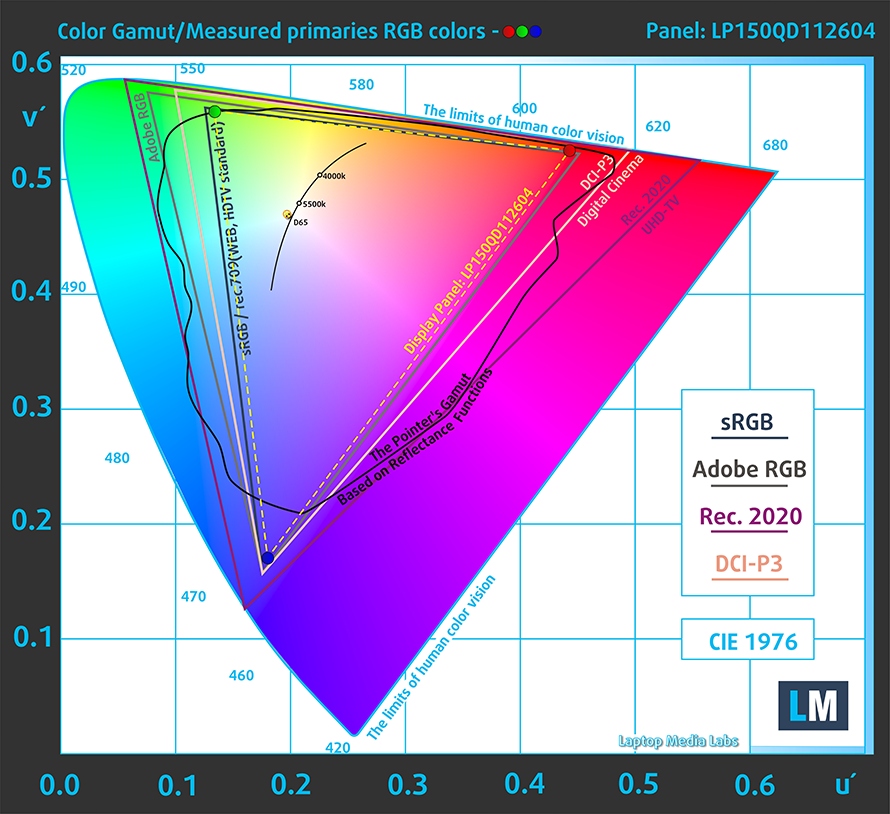
Our “Design and Gaming” profile delivers optimal color temperature (6500K) at 140 cd/m2 luminance and sRGB gamma mode.
We tested the accuracy of the display with 24 commonly used colors like light and dark human skin, blue sky, green grass, orange, etc. You can check out the results at factory condition and also, with the “Design and Gaming” profile.
Below you can compare the scores of Microsoft Surface Book 3 (15) with the default settings (left), and with the “Gaming and Web design” profile (right).
The next figure shows how well the display can reproduce dark parts of an image, which is essential when watching movies or playing games in low ambient light.
The left side of the image represents the display with stock settings which are excellent, while the right one is with the “Gaming and Web Design” profile activated. On the horizontal axis, you will find the grayscale, and on the vertical axis – the luminance of the display. On the two graphs below you can easily check for yourself how your display handles the darkest nuances but keep in mind that this also depends on the settings of your current display, the calibration, the viewing angle, and the surrounding light conditions.

Health impact – PWM / Blue Light
PWM (Screen flickering)
Pulse-width modulation (PWM) is an easy way to control monitor brightness. When you lower the brightness, the light intensity of the backlight is not lowered, but instead turned off and on by the electronics with a frequency indistinguishable to the human eye. In these light impulses, the light/no-light time ratio varies, while brightness remains unchanged, which is harmful to your eyes. You can read more about that in our dedicated article on PWM.
Microsoft Surface Book 3 (15)’s display uses PWM for brightness adjustment up until 100 nits and with a relatively high frequency. This makes it comfortable for your eyes during long work periods in this aspect.

Blue light emissions
Installing our Health-Guard profile not only eliminates PWM but also reduces the harmful Blue Light emissions while keeping the colors of the screen perceptually accurate. If you’re not familiar with the Blue light, the TL;DR version is – emissions that negatively affect your eyes, skin, and your whole body. You can find more information about that in our dedicated article on Blue Light.
Conclusions
Microsoft Surface Book 3 (15)’s display has a touchscreen IPS panel with a very high resolution (near 4K), comfortable viewing angles, a very good contrast ratio, and 92% sRGB coverage. Its factory calibration is pretty decent, but when our Gaming and Web design profile is applied, the color-accuracy improves even further to a standard-matching level. This makes it usable for Web design, creative work, and e-commerce. However, our particular unit suffered from a severe non-uniformity in the top right corner, which declassifies it for the aforementioned workflow, should you desire perfection. On the bright side, the panel doesn’t use aggressive PWM so it’s generally safe for work.
Buy our profiles
Since our profiles are tailored for each display model, this article and its respective profile package are meant for Microsoft Surface Book 3 (15) configurations with 15.0″ LP150QD112604 (3240 x 2160) IPS panel.
*Should you have problems with downloading the purchased file, try using a different browser to open the link you’ll receive via e-mail. If the download target is a .php file instead of an archive, change the file extension to .zip or contact us at [email protected].
Read more about the profiles HERE.
Además de recibir perfiles eficientes y respetuosos con la salud, al comprar los productos de LaptopMedia también apoyas el desarrollo de nuestros laboratorios, donde probamos los dispositivos para elaborar las reseñas más objetivas posibles.

Trabajo de oficina
El perfil Trabajo de Oficina debería ser utilizado sobre todo por usuarios que pasan la mayor parte del tiempo mirando trozos de texto, tablas o simplemente navegando. Este perfil pretende ofrecer una mayor nitidez y claridad manteniendo una curva de gamma plana (2,20), una temperatura de color nativa y colores perceptualmente precisos.

Diseño y juego
Este perfil está dirigido a los diseñadores que trabajan con los colores de forma profesional, y también para juegos y películas. Design and Gaming lleva a los paneles de visualización a sus límites, haciéndolos tan precisos como sea posible en el estándar sRGB IEC61966-2-1 para Web y HDTV, en el punto blanco D65.

Salud-Guardia
Salud-Guardia elimina la perjudicial Modulación de Ancho de Pulso (PWM) y reduce la luz azul negativa que afecta a nuestros ojos y a nuestro cuerpo. Al estar adaptado a cada panel, consigue mantener los colores perceptivamente precisos. Salud-Guardia simula el papel, por lo que la presión sobre los ojos se reduce considerablemente.
Consigue los 3 perfiles con un 33% de descuento
Sound
Microsoft Surface Book 3 (15)’s speakers have very good sound quality. Its low, mid, and high clocks are clear of deviations.
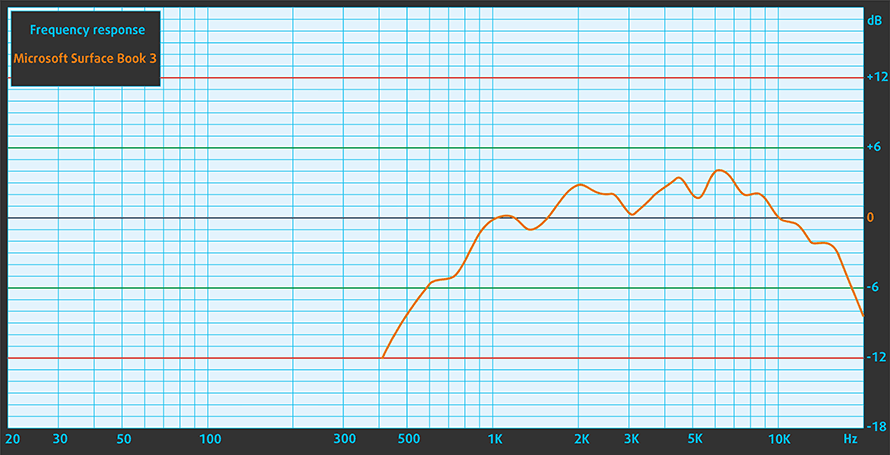
Drivers
All of the drivers and utilities for this notebook can be found here: https://www.microsoft.com/en-us/download/default.aspx
Battery
Now, we conduct the battery tests with Windows Better performance setting turned on, screen brightness adjusted to 120 nits, and all other programs turned off except for the one we are testing the notebook with. When it is in its final form, this laptop lasts for 10 hours and 43 minutes of Web browsing and 9 hours and 3 minutes of video playback. However, if you’re using only the tablet part, your battery life will drop down to 4 hours and 4 minutes of Web browsing and 3 hours and 3 minutes of video playback.
Para simular las condiciones de la vida real, utilizamos nuestro propio script de navegación automática por más de 70 sitios web.
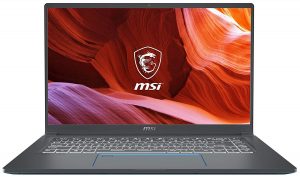
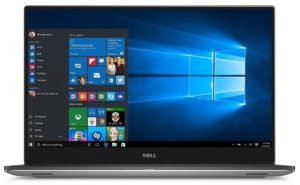
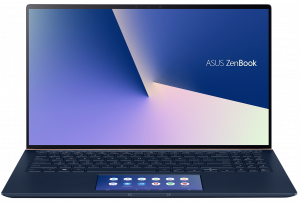

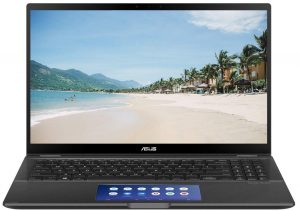
Para cada prueba de este tipo, utilizamos el mismo vídeo en HD.





CPU options
You don’t really have options here. Microsoft provides only the Intel Core i7-1065G7 for the Surface Book 3 (15). It has four cores and eight threads and is built on the 10nm Ice Lake architecture.
Los resultados proceden de la prueba de CPU Cinebench 20 (cuanto mayor sea la puntuación, mejor)
Los resultados proceden de nuestra prueba de referencia de Photoshop (cuanto más baja sea la puntuación, mejor)
GPU options
The same goes for the graphics options – you only get the GeForce GTX 1660 Ti Max-Q with 6GB of GDDR6 memory.
Los resultados proceden de la prueba 3DMark: Time Spy (Graphics) (cuanto mayor sea la puntuación, mejor)
Los resultados proceden de la prueba 3DMark: Fire Strike (Graphics) (cuanto mayor sea la puntuación, mejor)
Los resultados proceden de la prueba comparativa Unigine Superposition (cuanto mayor sea la puntuación, mejor)
Gaming tests

| Far Cry 5 | Full HD, Normal (Check settings) | Full HD, High (Check settings) | Full HD, Ultra (Check settings) |
|---|---|---|---|
| Average fps | 72 fps | 69 fps | 63 fps |

| Rise of the Tomb Raider (2016) | Full HD, Medium (Check settings) | Full HD, Very High (Check settings) | Full HD, MAX (Check settings) |
|---|---|---|---|
| Average fps | 90 fps | 54 fps | 36 fps |

| Tom Clancy’s Ghost Recon Wildlands | Full HD, High (Check settings) | Full HD, Very High (Check settings) | Full HD, Ultra (Check settings) |
|---|---|---|---|
| Average fps | 56 fps | 50 fps | 33 fps |

| Shadow of the Tomb Raider (2018) | Full HD, Medium (Check settings) | Full HD, High (Check settings) | Full HD, Highest (Check settings) |
|---|---|---|---|
| Average fps | 68 fps | 62 fps | 37 fps |
Temperatures and comfort
Max CPU load
In this test we use 100% on the CPU cores, monitoring their frequencies and chip temperature. The first column shows a computer’s reaction to a short load (2-10 seconds), the second column simulates a serious task (between 15 and 30 seconds), and the third column is a good indicator of how good the laptop is for long loads such as video rendering.
Average core frequency (base frequency + X); CPU temp.
| Intel Core i7-1065G7 (15W TDP) | 0:02 – 0:10 sec | 0:15 – 0:30 sec | 10:00 – 15:00 min |
|---|---|---|---|
| Microsoft Surface Book 3 (15) | 2.74 GHz (B+111%) @ 99°C | 2.55 GHz (B+96%) @ 99°C | 2.23 GHz (B+72%) @ 99°C |
| Dell Inspiron 14 5401 | 2.58 GHz (B+98%) @ 97°C | 2.23 GHz (B+72%) @ 98°C | 1.67 GHz (B+28%) @ 77°C |
| Microsoft Surface Book 3 (13.5) | 3.35 GHz (B+158%) @ 99°C | 3.04 GHz (B+134%) @ 99°C | 1.89 GHz (B+45%) @ 70°C |
| Acer Spin 5 (SP513-54N) | 2.40 GHz (B+85%) @ 72°C | 2.38 GHz (B+75%) @ 86°C | 2.12 GHz (B+63%) @ 92°C |
| HP Spectre x360 13 (13-aw0000) | 2.93 GHz (B+125%) @ 97°C | 1.97 GHz (B+52%) @ 76°C | 1.85 GHz (B+42%) @ 76°C |
| HP Pavilion 15 (15-cs3000) | 2.94 GHz (B+126%) @ 93°C | 2.03 GHz (B+56%) @ 77°C | 1.91 GHz (B+47%) @ 67°C |
| Dell Inspiron 15 3593 | 2.78 GHz (B+114%) @ 97°C | 2.31 GHz (B+78%) @ 93°C | 2.04 GHz (B+57%) @ 90°C |
Well, obviously the cooling can’t handle the Core i7-1065G7 very well. We didn’t see the temperature moving from 99C at any point throughout the test. Yes, the clock speed at the end is respectable, and in fact, the highest we’ve seen on this CPU. And if it wasn’t for this extreme workload, we would have never figured out that this laptop actually has a fan behind its display.
Real-life gaming
| NVIDIA GeForce GTX 1660 Ti Max-Q | GPU frequency/ Core temp (after 2 min) | GPU frequency/ Core temp (after 30 min) |
|---|---|---|
| Microsoft Surface Book 3 (15) | 1633 MHz @ 79°C | 1415 MHz @ 67°C |
| HP Pavilion Gaming 16 (16-a0000) | 1461 MHz @ 70°C | 1456 MHz @ 72°C |
| HP Pavilion Gaming 15 (15-ec0000) | 1511 MHz @ 66°C | 1493 MHz @ 68°C |
| ASUS ROG Zephyrus GA502 | 1396 MHz @ 78°C | 1432 MHz @ 81°C |
| HP Pavilion Gaming 15 2019 | 1400 MHz @ 66°C | 1365 MHz @ 71°C |
| HP Pavilion Gaming 17 2019 | 1334 MHz @ 67°C | 1282 MHz @ 75°C |
Interestingly, the Surface Book 3 (15) starts off very well with a high frequency and a TGP of 65W. However, after about 2 minutes, the power limit drops down to 48W and remains like that until the end of the test, which was 30 minutes in this case. This is the main reason that despite its relatively high frequency at the end, compared to some other laptops using the GTX 1660 Ti Max-Q, we saw an inferior performance.
Comfort during combined load
Thankfully, the fan on the “tablet” part is very subtle and pretty quiet even under an extreme workload. And although we were clearly hearing the dual fans, cooling the GPU, it was not too loud, either. Moreover, the hottest spot on the keyboard was about 45C, which is reasonable, considering the pretty powerful graphics card inside.
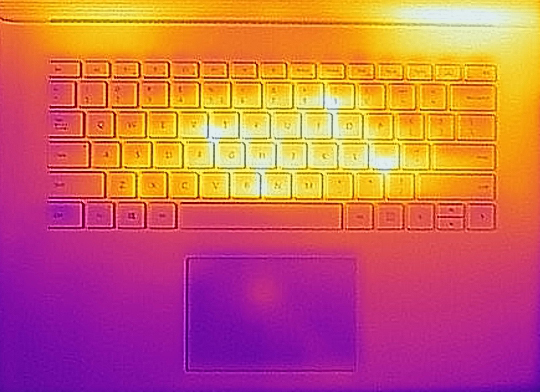

Verdict
 There is so much to talk about here. We’ll try to be as brief as possible, but the Surface Book 3 (15) is not your average convertible. In fact, it can be both laptop and a tablet, and it will work great both ways. Also, buying a Microsoft product means that you get the most optimized Windows experience, that you can ever get.
There is so much to talk about here. We’ll try to be as brief as possible, but the Surface Book 3 (15) is not your average convertible. In fact, it can be both laptop and a tablet, and it will work great both ways. Also, buying a Microsoft product means that you get the most optimized Windows experience, that you can ever get.
Let’s start with the battery life. If you’re planning to use the 15-inch display mainly as a tablet, you should think twice. The screen on time we got from it, alone, was about four hours of Web browsing and 3 hours of video playback. One at a time. This is far from everything in its class and is unworkable in our opinion. However, when you use the entire package, the battery life skyrockets to more than 10 hours and a half of Web browsing and about 9 hours of video playback, which is basically more than a full workday. Keep in mind that using heavy-load applications will heavily impact your battery life.
Microsoft Surface Book 3 (15)’s display has a touchscreen IPS panel (LP150QD112604) with a very high resolution (near 4K), comfortable viewing angles, very good contrast ratio, and 92% sRGB coverage. Its factory calibration is pretty decent, but when our Gaming and Web design profile is applied, the color-accuracy improves even further to a standard-matching level. This makes it usable for Web design, creative work, and e-commerce. However, our particular unit suffered from a severe non-uniformity in the top right corner, which declassifies it for the aforementioned workflow, should you desire perfection. On the bright side, the panel doesn’t use aggressive PWM so it’s generally safe for work.
Another thing we should mention is that in terms of performance, the entire package is not the best out there. Both in benchmarks and in real-life gaming we saw the GTX 1660 Ti Max-Q to be significantly slower than some of its competitors, in the face of the HP Pavilion Gaming family. However, this doesn’t mean you shouldn’t or can’t game on the Surface Book 3 (15). Quite the opposite, actually. It is just a unique product that so far has no competition, and the fact that you have the power (although limited) of this graphics card is pleasant. By the way, the reason for the lower performance is a quite lower power limit with the TGP plummeting from 65W to 48W after just a couple of minutes into a game.
Other than that, you have the privilege of two USB Type-A ports, a USB Type-C port, and a full-sized SD card reader. The laptop also provides support for Wi-Fi 6 connectivity, the Surface Pen, the Surface Dial, 1080p conference calls, and Windows Hello log-in.
If we have to be honest if you have the budget, and you need something truly unique, that will guide your professional needs, the Surface Book 3 (15) is a very good choice, despite its little quirks.
Pros
- Beautiful screen with 92% of sRGB coverage and accurate colors (when our Gaming and Web design profile is present) (LP150QD112604)
- Doesn’t use aggressive PWM to adjust brightness (LP150QD112604)
- Very high resolution and maximum brightness and a pro-friendly 3:2 aspect ratio (LP150QD112604)
- 1080p Webcam
- Magnesium build with a unique attachment that can hold the display turned in both sides
- Windows Hello, Wi-Fi 6, and optional Surface Pen and Surface Dial
- Modest but useful I/O with an SD card reader
Cons
- Very hard to upgrade
- The tablet has a very short battery life by itself
- The GTX 1660 Ti Max-Q works at a lower TGP after a couple of minutes of load
You can check the prices and configurations in our Specs System: https://laptopmedia.com/series/microsoft-surface-book-3-15-0/
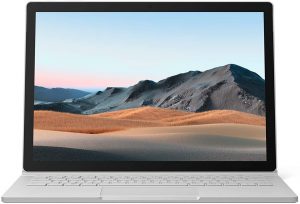

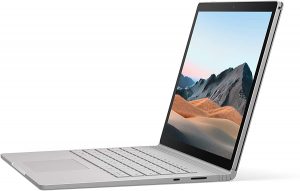
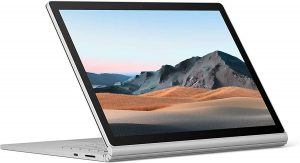
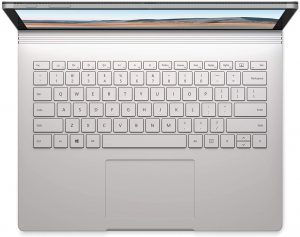
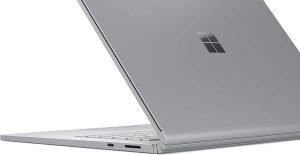
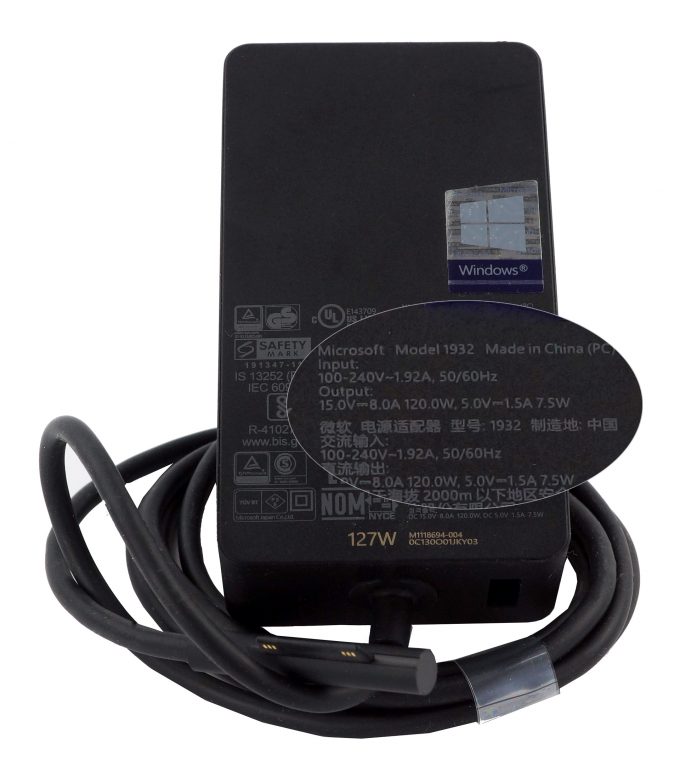


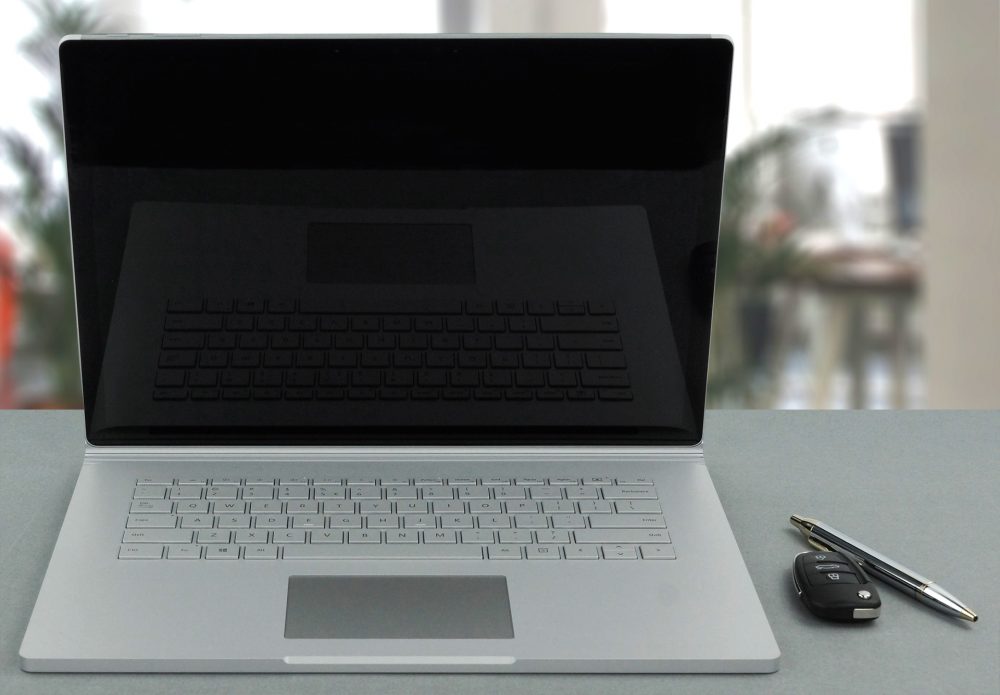
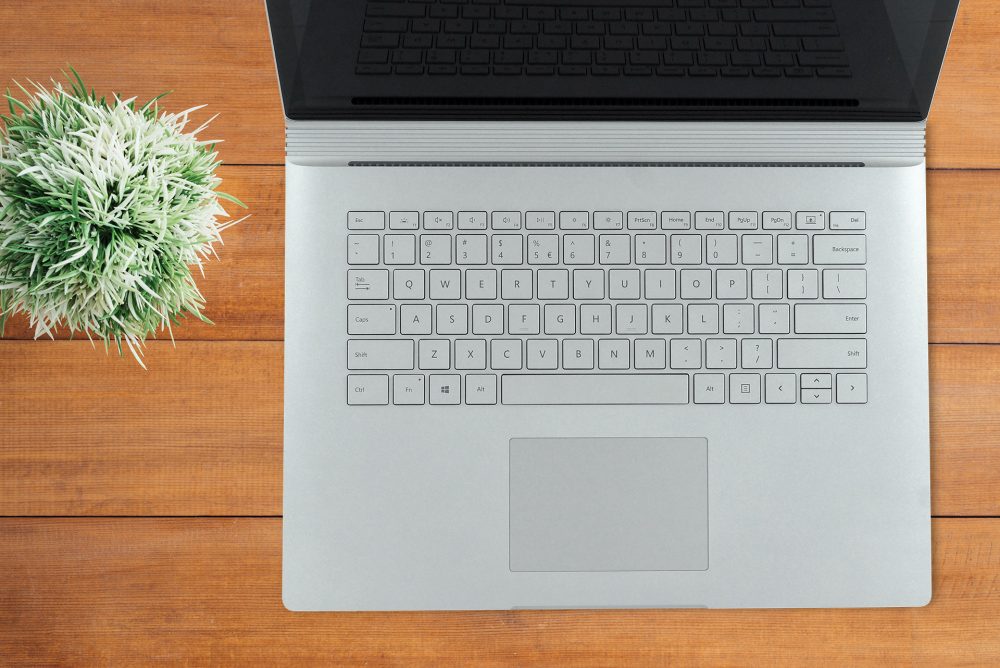
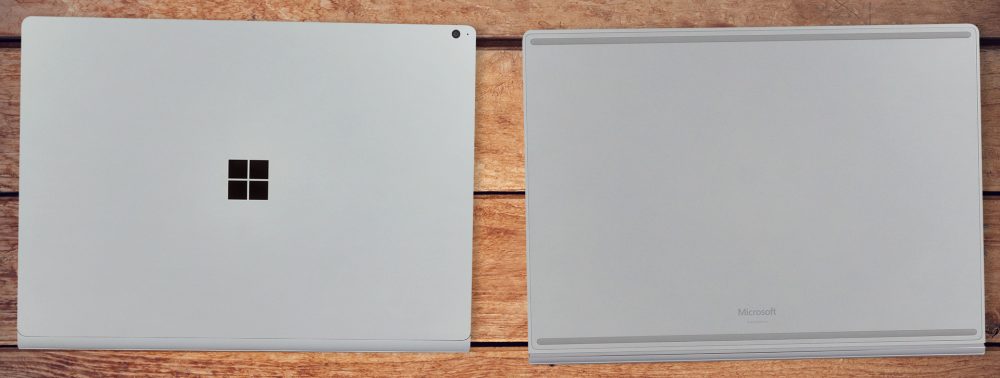


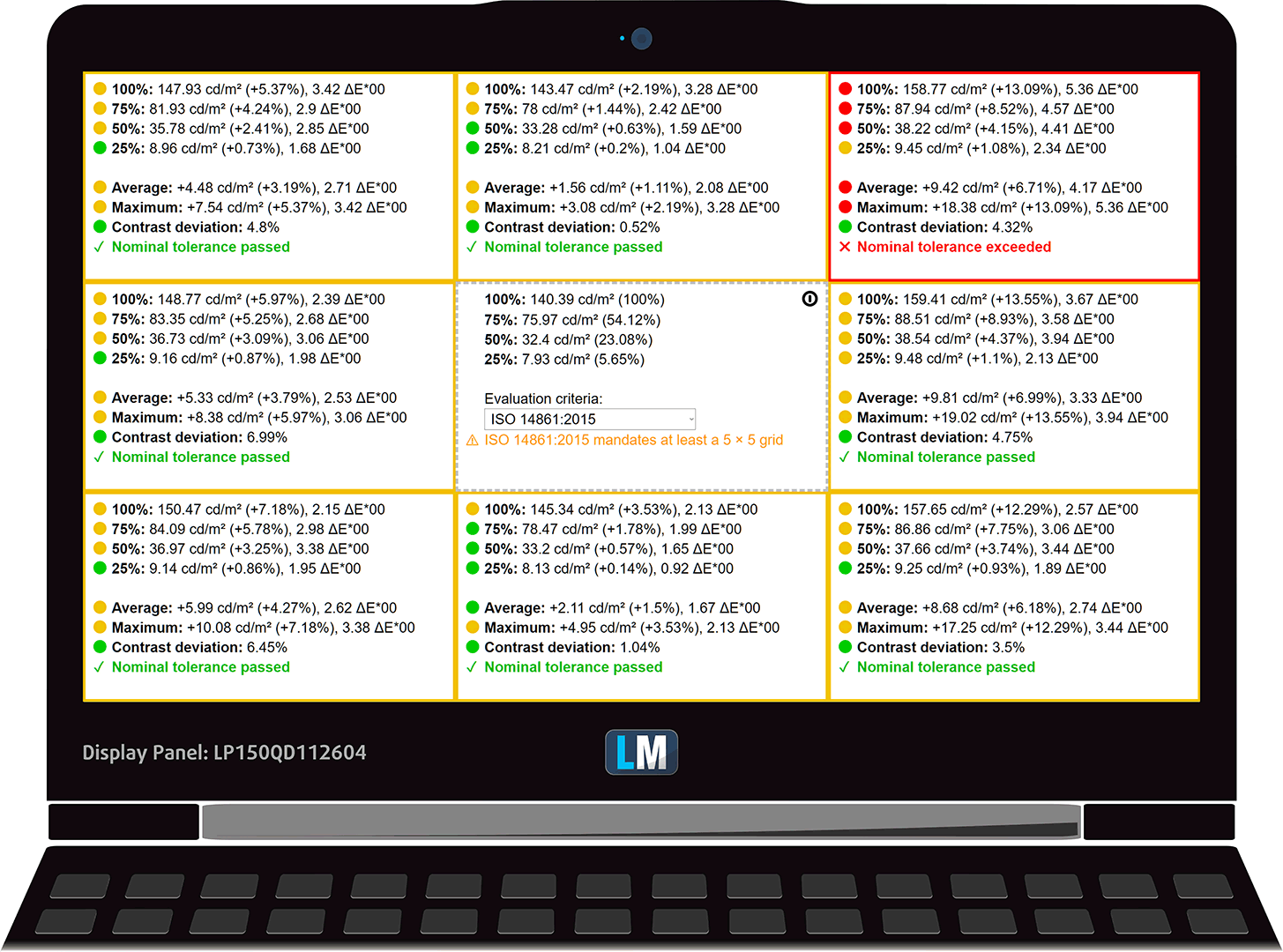

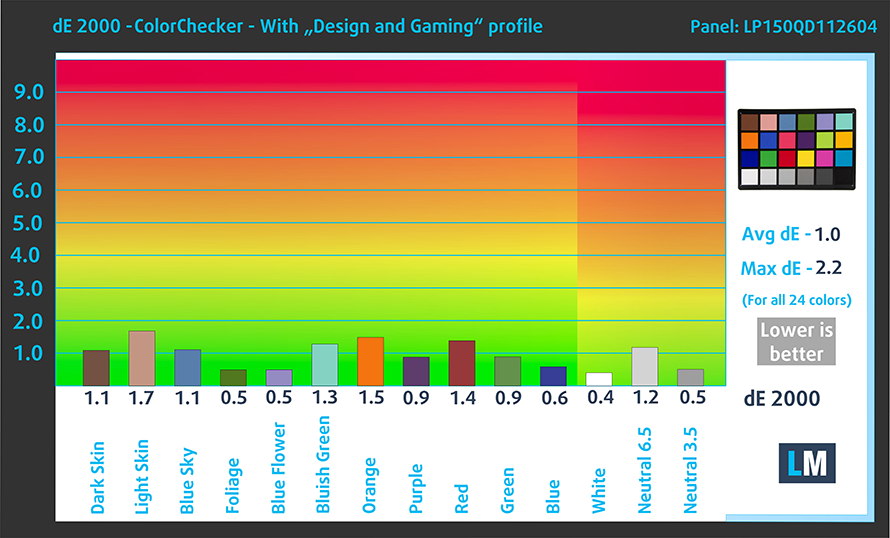

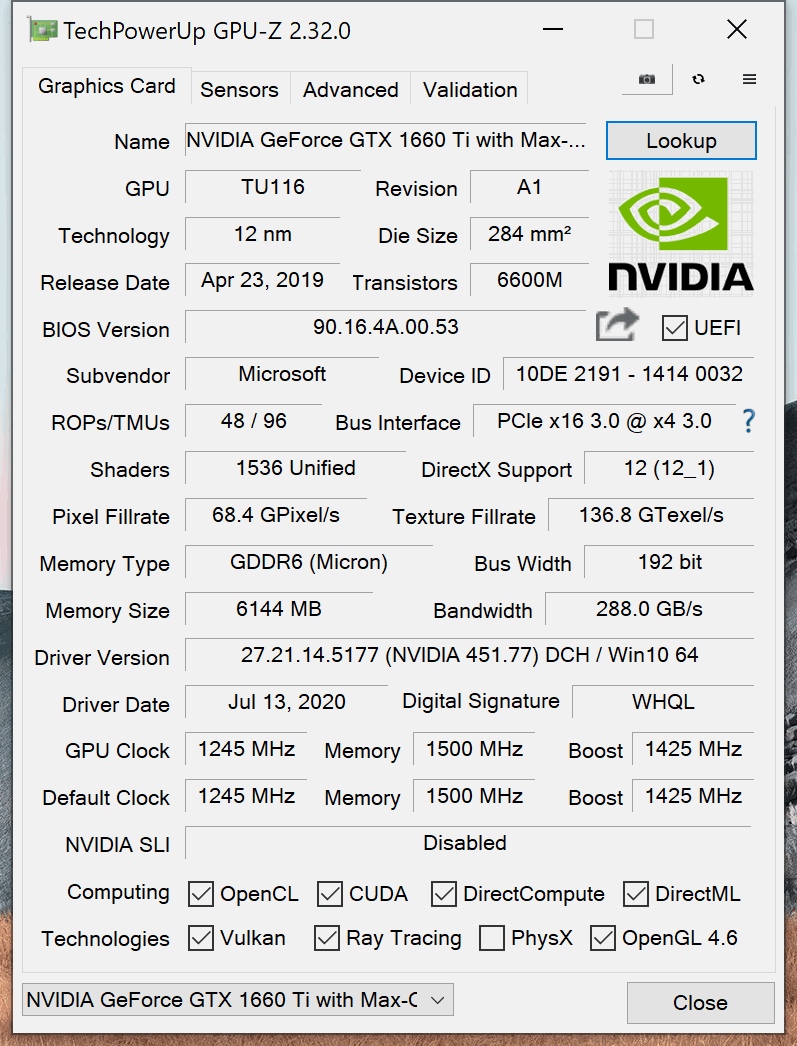







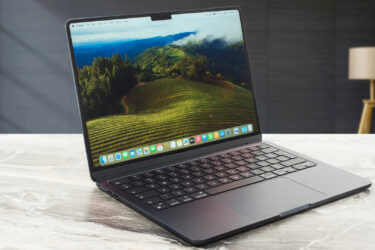
I bought this but had to return it within 3 days because the touchscreen was consistently faulty/erratic – touch and pen capability would stop suddenly for no reason. Microsoft offered an immediate refund, as I think this is a well documented glitch?
maybe you’re out of luck, i’m using it very well